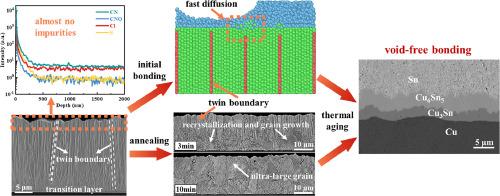通过纳米缠绕铜的微结构演变提高铜锡键合的可靠性
IF 8.3
1区 材料科学
Q1 MATERIALS SCIENCE, MULTIDISCIPLINARY
引用次数: 0
摘要
Kirkendall 空隙不利于铜锡结合界面,导致高密度封装失效。在此,通过控制电沉积程序制备了垂直排列的纳米铜(p-ntCu)和水平排列的纳米铜(h-ntCu)。p-ntCu 在快速键合过程和通过原位微结构演化抑制空隙方面都具有优势。与 h-ntCu 相比,p-ntCu 中大量垂直排列的孪晶边界为建立键合界面提供了快速的相互扩散路径。在键合过程中,p-ntCu 长成平均晶粒尺寸为 6.68 μm 的超大晶粒铜。p-ntCu 中正常晶界密度的降低降低了铜的扩散速率,并有助于在键合界面形成更平衡的相互扩散,这一点已通过金属间化合物(IMC)生长的分子动力学模拟和动力学计算得到证实。此外,p-ntCu 中的低杂质含量进一步降低了扩散通量的不平衡,并限制了 Kirkendall 空位的成核。因此,在减少晶界扩散和降低杂质含量的协同作用下,p-ntCu/Sn 界面在 150 °C 长期热老化过程中保持无空隙,这将有利于实现高可靠性的铜锡结合。本文章由计算机程序翻译,如有差异,请以英文原文为准。


Enhanced reliability of Cu-Sn bonding through the microstructure evolution of nanotwinned copper
Kirkendall voids are detrimental to the Cu-Sn bonding interface, causing the failure of the high-density package. Herein, the perpendicularly aligned nanotwinned Cu (p-ntCu) and the horizontally aligned nanotwinned Cu (h-ntCu) are prepared by controlling the electrodeposition procedure. The p-ntCu shows advantages both in fast-bonding process and in void suppression through the in-situ microstructure evolution. Compared with h-ntCu, the abundant perpendicularly aligned twin boundaries in p-ntCu provide fast interdiffusion paths to build a bonding interface. In the bonding process, p-ntCu grows to ultra-large-grained Cu with an average grain size of 6.68 μm. The reduced density of normal grain boundaries in p-ntCu lowers the Cu diffusion rate and contributes to more balanced interdiffusion at the bonding interface, which is confirmed by molecular dynamics simulation and kinetic calculations of intermetallic compound (IMC) growth. In addition, the low impurity content in p-ntCu further reduces the diffusion flux imbalance and limits the nucleation of Kirkendall vacancies. Consequently, the p-ntCu/Sn interface keeps void-free during 150 °C long-term thermal aging due to the synergistic effect of reduced grain-boundary diffusion and lower impurity content, which will be beneficial for achieving high-reliability Cu-Sn bonding.
求助全文
通过发布文献求助,成功后即可免费获取论文全文。
去求助
来源期刊

Acta Materialia
工程技术-材料科学:综合
CiteScore
16.10
自引率
8.50%
发文量
801
审稿时长
53 days
期刊介绍:
Acta Materialia serves as a platform for publishing full-length, original papers and commissioned overviews that contribute to a profound understanding of the correlation between the processing, structure, and properties of inorganic materials. The journal seeks papers with high impact potential or those that significantly propel the field forward. The scope includes the atomic and molecular arrangements, chemical and electronic structures, and microstructure of materials, focusing on their mechanical or functional behavior across all length scales, including nanostructures.
 求助内容:
求助内容: 应助结果提醒方式:
应助结果提醒方式:


